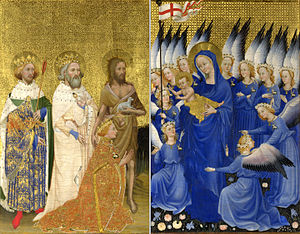
Religion in Medieval England includes all forms of religious organisation, practice and belief in England, between the end of Roman authority in the fifth century and the advent of the Tudor dynasty in the late fifteenth century. The collapse of Roman authority brought about the end of formal Christian religion in the east of what is now England as Germanic settlers established paganism in the large sections of the island that they controlled. The movement towards Christianity began again in the late sixth and seventh centuries. Pope Gregory I sent a team of missionaries who gradually converted most of the Anglo-Saxon kingdoms, while Scots-Irish monks were active in the north of England. The process was largely complete by the end of the seventh century, but left a confusing and disparate array of local practices and religious ceremonies. The Viking invasions of the eighth and ninth centuries reintroduced paganism to North-East England, leading in turn to another wave of conversions.
The process of conversions led to an explosion of local church buildings and monasteries formed the main basis for the church. Cathedrals were also constructed. These institutions were badly affected in the ninth century by Viking raids and predatory annexations by the nobility. Reforms followed under the kings of Wessex who promoted the Benedictine rule then popular on the Continent. The 1066 Norman conquest brought a new set of Norman and French churchmen to power; some adopted and embraced aspects of the former Anglo-Saxon religious system, while others introduced practices from Normandy. The French Cluniac order became fashionable and the Augustinians spread quickly from the beginning of the twelfth century, while later in the century the Cistercians reached England. The Dominican and Franciscan friars arrived in England during the 1220s, as well as the religious military orders that became popular across Europe from the twelfth century.
The Church had a close relationship with the English state throughout the Middle Ages. The bishops and major monastic leaders played an important part in national government. After the Norman Conquest kings and archbishops clashed over rights of appointment and religious policy. By the early thirteenth century the church had largely won its argument for independence. Pilgrimages were a popular religious practice throughout the Middle Ages in England. Participation in the Crusades was also seen as a form of pilgrimage, and England played a prominent part in the Second, Third and Fifth Crusades. In the 1380s, several challenges emerged to the traditional theology of the Church, resulting from the teachings of John Wycliffe.